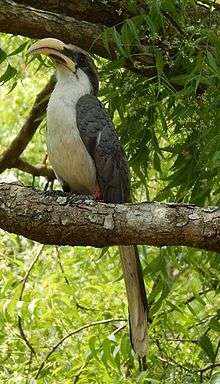Sri Lanka grey hornbill
| Sri Lanka grey hornbill | |
|---|---|
 | |
| at Mihintale, Sri Lanka | |
| Scientific classification | |
| Kingdom: | Animalia |
| Phylum: | Chordata |
| Class: | Aves |
| Order: | Bucerotiformes |
| Family: | Bucerotidae |
| Genus: | Ocyceros |
| Species: | O. gingalensis |
| Binomial name | |
| Ocyceros gingalensis Shaw, 1811 | |
The Sri Lanka grey hornbill (Ocyceros gingalensis) is a bird in the hornbill family and a widespread and common endemic resident breeder in Sri Lanka. Hornbills are a family of tropical near-passerine birds found in the Old World.
The Sri Lanka grey hornbill is a gregarious bird found in forest habitats. It feeds mostly on figs, although occasionally it eats small rodents, reptiles and insects. The female lays up to four white eggs in a tree hole blocked off during incubation with a cement made of mud, droppings and fruit pulp. There is only one narrow aperture, barely wide enough for the male to transfer food to the mother and chicks.
The Sri Lanka grey hornbill is a large bird at 45 centimetres (18 in) in length. It has grey wings with black primary flight feathers, a grey back, and a brown crown. Its long tail is blackish with white sides, and the underparts are white. The long, curved bill has no casque. Sexes are similar, although the male has a cream-coloured bill, whereas the female's is black with a cream stripe. Immature birds have dark grey upperparts, a cream bill, and a tail with a white tip. Its flight is slow and powerful.
These birds usually live in pairs or small flocks consisting up to five birds (2 adults and 2-3 juveniles). They are omnivores observed consuming berries, fruits, insects and small lizards.
In culture
In the Sinhala Language of Sri Lanka, this bird is known as Alu Kadatta' - 'අලු කෑදැත්තා'.
External links
References
- ↑ BirdLife International (2012). "Ocyceros gingalensis". IUCN Red List of Threatened Species. Version 2013.2. International Union for Conservation of Nature. Retrieved 26 November 2013.
- Birds of India by Grimmett, Inskipp and Inskipp, ISBN 0-691-04910-6
